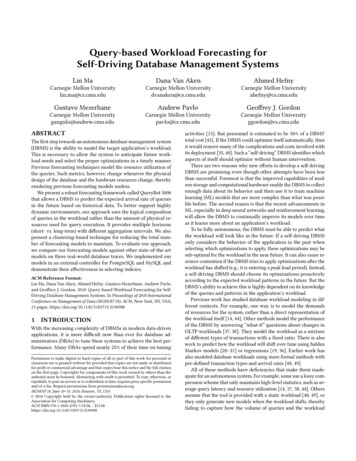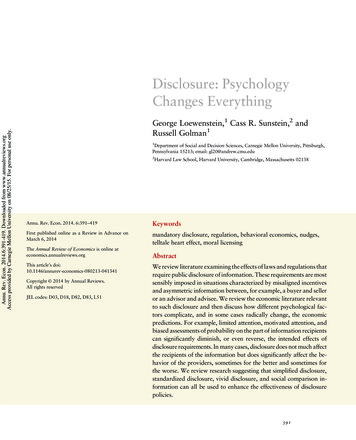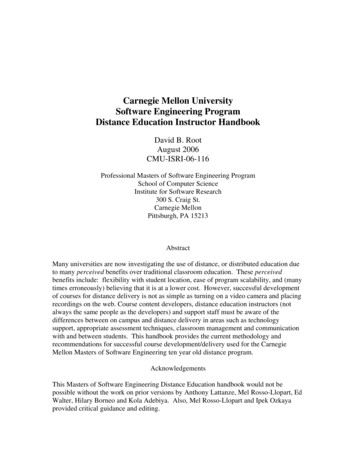
Transcription
GAME THEORYClass notes for Math 167, Fall 2000Thomas S. FergusonPart I. Impartial Combinatorial Games1. Take-Away Games.1.1 A Simple Take-Away Game.1.2 What is a Combinatorial Game?1.3 P-positions, N-positions.1.4 Subtraction Games.1.5 Exercises.2. The Game of Nim.2.1 Preliminary Analysis.2.2 Nim-Sum.2.3 Nim With a Larger Number of Piles.2.4 Proof of Bouton’s Theorem.2.5 Misère Nim.2.6 Exercises.3. Graph Games.3.1 Games Played on Directed Graphs.3.2 The Sprague-Grundy Function.3.3 Examples.3.4 The Use of the Sprague-Grundy Function.3.5 Exercises.4. Sums of Combinatorial Games.4.1 The Sum of n Graph Games.4.2 The Sprague Grundy Theorem.4.3 Applications.4.4 Take-and-Break Games.4.5 Exercises.I–1
5. Green Hackenbush.5.1 Bamboo Stalks.5.2 Green Hackenbush on Trees.5.3 Green Hackenbush on General Rooted Graphs.5.4 Exercises.References.I–2
Part I. Impartial Combinatorial Games1. Take-Away Games.Combinatorial games are two-person games with perfect information and no chancemoves, and with a win-or-lose outcome. Such a game is determined by a set of positions,including an initial position, and the player whose turn it is to move. Play moves from oneposition to another, with the players usually alternating moves, until a terminal positionis reached. A terminal position is one from which no moves are possible. Then one of theplayers is declared the winner and the other the loser.There are two main references for the material on combinatorial games. One is theresearch book, On Numbers and Games by J. H. Conway, Academic Press, 1976. Thisbook introduced many of the basic ideas of the subject and led to a rapid growth of thearea that continues today. The other reference, more appropriate for this class, is thetwo-volume book, Winning Ways for your mathematical plays by Berlekamp, Conway andGuy, Academic Press, 1982, in paperback. There are many interesting games described inthis book and much of it is accessible to the undergraduate mathematics student. Thistheory may be divided into two parts, impartial games in which the set of moves availablefrom any given position is the same for both players, and partizan games in which eachplayer has a different set of possible moves from a given position. Games like chess orcheckers in which one player moves the white pieces and the other moves the black piecesare partizan. In Part I, we treat only the theory of impartial games. An elementaryintroduction to impartial combinatorial games is given in the book Fair Game by RichardK. Guy, published in the COMAP Mathematical Exploration Series, 1989. We start witha simple example.1.1 A Simple Take-Away Game. Here are the rules of a very simple impartialcombinatorial game of removing chips from a pile of chips.(1) There are two players. We label them I and II.(2) There is a pile of 21 chips in the center of a table.(3) A move consists of removing one, two, or three chips from the pile. At least onechip must be removed, but no more than three may be removed.(4) Players alternate moves with Player I starting.(5) The player that removes the last chip wins. (The last player to move wins. If youcan’t move, you lose.)How can we analyze this game? Can one of the players force a win in this game?Which player would you rather be, the player who starts or the player who goes second?What is a good strategy?We analyze this game from the end back to the beginning. This method is sometimescalled backward induction.I–3
If there are just one, two, or three chips left, the player who moves next winssimply by taking all the chips.Suppose there are four chips left. Then the player who moves next mustleave either one, two or three chips in the pile and his opponent will be able towin. So four chips left is a loss for the next player to move and a win for theprevious player, i.e. the one who just moved.With 5, 6, or 7 chips left, the player who moves next can win by moving tothe position with four chips left.With 8 chips left, the next player to move must leave 5, 6, or 7 chips, and sothe previous player can win.We see that positions with 0, 4, 8, 12, 16, . . . chips are target positions; wewould like to move into them. We may now analyze the game with 21 chips.Since 21 is not divisible by 4, the first player to move can win. The uniqueoptimal move is to take one chip and leave 20 chips which is a target position.1.2 What is a Combinatorial Game? We now define the notion of a combinatorialgame more precisely. It is a game that satisfies the following conditions.(1) There are two players.(2) There is a set, usually finite, of possible positions of the game.(3) The rules of the game specify for both players and each position which moves toother positions are legal moves. If the rules make no distinction between the players, thatis if both players have the same options of moving from each position, the game is calledimpartial; otherwise, the game is called partizan.(4) The players alternate moving.(5) The game ends when a position is reached from which no moves are possible forthe player whose turn it is to move. Under the normal play rule, the last player to movewins. Under the misère play rule the last player to move loses.If the game never ends, it is declared a draw. However, we shall nearly always addthe following condition, called the ending condition. This eliminates the possibility ofa draw.(6) The game ends in a finite number of moves no matter how it is played.It is important to note what is omitted in this definition. No random moves such as therolling of dice or the dealing of cards are allowed. This rules out games like backgammonand poker. A combinatorial game is a game of perfect information: simultaneous movesand hidden moves are not allowed. This rules out battleship and scissors-paper-rock. Nodraws in a finite number of moves are possible. This rules out tic-tac-toe. In these notes,we restrict attention to impartial games, generally under the normal play rule.1.3 P-positions, N-positions. Returning to the take-away game of Section 1.1,we see that 0, 4, 8, 12, 16, . . . are positions that are winning for the Previous player (theplayer who just moved) and that 1, 2, 3, 5, 6, 7, 9, 10, 11, . . . are winning for the Next playerto move. The former are called P-positions, and the latter are called N-positions. TheI–4
P-positions are just those with a number of chips divisible by 4, called target positions inSection 1.1.In impartial combinatorial games, one can find in principle which positions are Ppositions and which are N-positions by (possibly transfinite) induction using the followinglabeling procedure starting at the terminal positions. We say a position in a game is aterminal position, if no moves from it are possible. This algorithm is just the methodwe used to solve the take-away game of Section 1.1.Step 1: Label every terminal position as a P-position.Step 2: Label every position that can reach a labelled P-position in one move as anN-position.Step 3: Find those positions whose only moves are to labelled N-positions; label suchpositions as P-positions.Step 4: If no new P-positions were found in step 3, stop; otherwise return to step 2.It is easy to see that the strategy of moving to P-positions wins. From a P-position,your opponent can move only to an N-position (3). Then you may move back to a Pposition (2). Eventually the game ends at a terminal position and since this is a P-position,you win (1).Here is a characterization of P-positions and N-positions that is valid for impartialcombinatorial games satisfying the ending condition, under the normal play rule.P-positions and N-positions are defined recursively by the following three statements.(1) All terminal positions are P-positions.(2) From every N-position, there is at least one move to a P-position.(3) From every P-position, every move is to an N-position.For games using the misére play rule, condition (1) should be replaced by the conditionthat all terminal positions are N-positions.1.4 Subtraction Games. Let us now consider a class of combinatorial games thatcontains the take-away game of Section 1.1 as a special case. Let S be a set of positiveintegers. The subtraction game with subtraction set S is played as follows. From a pilewith a large number, say n, of chips, two players alternate moves. A move consists ofremoving s chips from the pile where s S. Last player to move wins.The take-away game of Section 1.1 is the subtraction game with subtraction set S {1, 2, 3}. In Exercise 1.2, you are asked to analyze the subtraction game with subtractionset S {1, 2, 3, 4, 5, 6}.For illustration, let us analyze the subtraction game with subtraction set S {1, 3, 4}by finding its P-positions. There is exactly one terminal position, namely 0. Then 1, 3,and 4 are N-positions, since they can be moved to 0. But 2 then must be a P-positionsince the only legal move from 2 is to 1, which is an N-position. Then 5 and 6 must beN-positions since they can be moved to 2. Now we see that 7 must be a P-position sincethe only moves from 7 are to 6, 4, or 3, all of which are N-positions.Now we continue similarly: we see that 8, 10 and 11 are N-positions, 9 is a P-position,12 and 13 are N-positions and 14 is a P-position. This extends by induction. We findI–5
that the set of P-positions is P {0, 2, 7, 9, 14, 16, . . .}, the set of nonnegative integersleaving remainder 0 or 2 when divided by 7. The set of N-positions is the complement,N {1, 3, 4, 5, 6, 8, 10, 11, 12, 13, 15, . . .}.x 0 1position P N2 3P N4N5N6 7N P8 9N P10N11 12N N13N14 . . .P .The pattern P NP NNNN of length 7 repeats forever.Who wins the game with 100 chips, the first player or the second? The P-positionsare the numbers equal to 0 or 2 modulus 7. Since 100 has remainder 2 when divided by 7,100 is a P-position; the second player to move can win with optimal play.1.5 Exercises.1. Consider the misère version of the take-away game of Section 1.1, where the lastplayer to move loses. The object is to force your opponent to take the last chip. Analyzethis game. What are the target positions (P-positions)? (You can play the normal versionof the game at http://207.106.82.89/puzzles/23match/23match.htm .)2. Generalize the Take-Away Game: (a) Suppose in a game with a pile containing alarge number of chips, you can remove any number from 1 to 6 chips at each turn. Whatis the winning strategy? What are the P-positions? (b) If there are initially 31 chips inthe pile, what is your winning move, if any?3. The Thirty-one Game. (Geoffrey Mott-Smith (1954)) From a deck of cards,take the Ace, 2, 3, 4, 5, and 6 of each suit. These 24 cards are laid out face up on a table.The players alternate turning over cards and the sum of the turned over cards is computedas play progresses. Each Ace counts as one. The player who first makes the sum go above31 loses. It would seem that this is equivalent to the game of the previous exercise playedon a pile of 31 chips. But there is a catch. No integer may be chosen more than four times.(a) If you are the first to move, and if you use the strategy found in the previous exercise,what happens if the opponent keeps choosing 4?(b) Nevertheless, the first player can win with optimal play. How?4. Find the set of P-positions for the subtraction games with subtraction sets(a) S {1, 3, 5, 7}.(b) S {1, 3, 6}.(c) S {1, 2, 4, 8, 16, . . .} all powers of 2.(d) Who wins each of these games if play starts at 100 chips, the first player or the second?5. Empty and Divide. There are two boxes. Initially, one box contains m chipsand the other contains n chips. Such a position is denoted by (m, n), where m 0 andn 0. The two players alternate moving. A move consists of emptying one of the boxes,and dividing the contents of the other between the two boxes with at least one chip in eachbox. There is a unique terminal position, namely (1, 1). Last player to move wins. Findall P-positions.6. Chomp! A game invented by Fred. Schuh (1952) in an arithmetical form wasdiscovered independently in a completely different form by David Gale (1974). Gale’sversion of the game involves removing squares from a rectangular board, say an m by nI–6
board. A move consists in taking a square and removing it and all squares to the rightand above. Players alternate moves, and the person to take square (1, 1) loses. Thename “Chomp” comes from imagining the board as a chocolate bar, and moves involvingbreaking off some corner squares to eat. The square (1, 1) is poisoned though; the playerwho chomps it loses. You can play this game on the web athttp://207.106.82.89/puzzles/chomp/chomp.htm .For example, starting with an 8 by 3 board, suppose the first player chomps at (6, 2)gobbling 6 pieces, and then second player chomps at (2, 3) gobbling 4 pieces, leaving thefollowing board, wheredenotes the poisoned piece. (a) Show that this position is a N-position, by finding a winning move for the firstplayer. (It is unique.)(b) It is known that the first player can win all rectangular starting positions. Theproof, though ingenious, is not hard. However, it is an “existence” proof. It shows thatthere is a winning strategy for the first player, but gives no hint on how to find the firstmove! See if you can find the proof. Here is a hint: Does removing the upper right cornerconstitute a winning move?7. Dynamic subtraction. One can enlarge the class of subtraction games by lettingthe subtraction set depend on the last move of the opponent. Many early examples appearin Chapter 12 of Schuh (1968). Here are two other examples. (For a generalization, seeSchwenk (1970).)(a) There is one pile of n chips. The first player to move may remove as many chips asdesired, at least one chip but not the whole pile. Thereafter, the players alternate moving,each player not being allowed to remove more chips than his opponent took on the previousmove. What is an optimal move for the first player if n 44? For what values of n doesthe second player have a win?(b) Fibonacci Nim. (Whinihan (1963)) The same rules as in (a), except that a playermay take at most twice the number of chips his opponent took on the previous move.The analysis of this game is more difficult than the game of part (a) and depends on thesequence of numbers named after Leonardo Pisano Fibonacci, which may be defined asF1 1, F2 2, and Fn 1 Fn Fn 1 for n 2. The Fibonacci sequence is thus:1, 2, 3, 5, 8, 13, 21, 34, 55, . . . The solution is facilitated byZeckendorf ’s Theorem. Every positive integer can be written uniquely as a sum ofdistinct non-neighboring Fibonacci numbers.There may be many ways of writing a number as a sum of Fibonacci numbers, butthere is only one way of writing it as a sum of non-neighboring Fibonacci numbers. Thus,43 34 8 1 is the unique way of writing 43, since although 43 34 5 3 1, 5 and 3 areI–7
neighbors. What is an optimal move for the first player if n 43? For what values of ndoes the second player have a win?8. The SOS Game. (From the 28th Annual USA Mathematical Olympiad, 1999)The board consists of a row of n squares, initially empty. Players take turns selecting anempty square and writing either an S or an O in it. The player who first succeeds incompleting SOS in consecutive squares wins the game. If the whole board gets filled upwithout an SOS appearing consecutively anywhere, the game is a draw.(a) Suppose n 4 and the first player puts an S in the first square. Show the secondplayer can win.(b) Show that if n 7, the first player can win the game.(c) Show that if n 2000, the second player can win the game.(d) Who wins the game if n 14?I–8
2. The Game of Nim.The most famous take-away game is the game of Nim, played as follows. Thereare three piles of chips containing x1 , x2 , and x3 chips respectively. (Piles of sizes 5,7, and 9 make a good game.) Two players take turns moving. Each move consists ofselecting one of the piles and removing chips from it. You may not remove chips frommore than one pile in one turn, but from the pile you selected you may remove as manychips as desired, from one chip to the whole pile. The winner is the player who removes the last chip. You can play this game on the web with four piles at Game of Nim(http://www.thebestweb.com/iss/testOfGame.asp ), or with even more piles at Nim Game(http://www.dotsphinx.com/nim/).2.1 Preliminary Analysis. There is exactly one terminal position, namely (0, 0, 0),which is therefore a P-position. The solution to one-pile Nim is trivial: you simply removethe whole pile. Any position with exactly one non-empty pile, say (0, 0, x) with x 0is therefore an N-position. Consider two-pile Nim. It is easy to see that the P-positionsare those for which the two piles have an equal number of chips, (0, 1, 1), (0, 2, 2), etc.This is because if it is the opponent’s turn to move from such a position, he must changeto a position in which the two piles have an unequal number of chips, and then you canimmediately return to a position with an equal number of chips (perhaps the terminalposition).If all three piles are non-empty, the situation is more complicated. Clearly, (1, 1, 1),(1, 1, 2), (1, 1, 3) and (1, 2, 2) are all N-positions because they can be moved to (1, 1, 0) or(0, 2, 2). The next simplest position is (1, 2, 3) and it must be a P-position because it canonly be moved to one of the previously discovered N-positions. We may go on and discoverthat the next most simple P-positions are (1, 4, 5), and (2, 4, 6), but it is difficult to seehow to generalize this. Is (5, 7, 9) a P-position? Is (15, 23, 30) a P-position?If you go on with the above analysis, you may discover a pattern. But to save ussome time, I will describe the solution to you. Since the solution is somewhat fanciful andinvolves something called nim-sum, the validity of the solution is not obvious. Later, weprove it to be valid using the elementary notions of P-position and N-position.2.2 Nim-Sum. The nim-sum of two non-negative integers is their addition withoutcarry in base 2. Let us make this notion precise.Every non-negative integer x has a unique base 2 representation of the form x xm 2 xm 1 2m 1 · · · x1 2 x0 for some m, where each xi is either zero or one. We usethe notation (xm xm 1 · · · x1 x0 )2 to denote this representation of x to the base two. Thus,22 1 · 16 0 · 8 1 · 4 1 · 2 0 · 1 (10110)2 . The nim-sum of two integers is foundby expressing the integers to base two and using addition modulo 2 on the correspondingindividual components:mDefinition. The nim-sum of (xm · · · x0 )2 and (ym · · · y0 )2 is (zm · · · z0 )2 , and we write(xm · · · x0 )2 (ym · · · y0 )2 (zm · · · z0 )2 , where for all k, zk xk yk (mod 2), that is,zk 1 if xk yk 1 and zk 0 otherwise.I–9
For example, (10110)2 (110011)2 (100101)2 . This says that 22 51 37. This iseasier to see if the numbers are written vertically (we also omit the parentheses for clarity):22 10110251 1100112nim-sum 1001012 37Nim-sum is associative (i.e. x (y z) (x y) z) and commutative (i.e. x y y x), since addition modulo 2 is. Thus we may write x y z without specifying theorder of addition. Furthermore, 0 is an identity for addition (0 x x), and every numberis its own inverse (x x 0), so that the cancellation law holds: x y x z impliesy z. (If x y x z, then x x y x x z, and so y z.)Thus, nim-sum has a lot in common with ordinary addition, but what does it have todo with playing the game of Nim? The answer is contained in the following theorem of C.L. Bouton (1902).Theorem 1. A position, (x1 , x2 , x3 ), in Nim is a P-position if and only if the nim-sum ofits components is zero, x1 x2 x3 0.As an example, take the position (x1 , x2 , x3 ) (13, 12, 8). Is this a P-position? If not,what is a winning move? We compute the nim-sum of 13, 12 and 8:13 12 8 nim-sum 11012110021000210012 9Since the nim-sum is not zero, this is an N-position according to Theorem 1. Can you finda winning move? You must find a move to a P-position, that is, to a position with an evennumber of 1’s in each column. One such move is to take away 9 chips from the pile of 13,leaving 4 there. The resulting position has nim-sum zero:4 100212 110028 10002nim-sum 00002 0Another winning move is to subtract 7 chips from the pile of 12, leaving 5. Check it out.There is also a third winning move. Can you find it?2.3 Nim with a Larger Number of Piles. We saw that 1-pile nim is trivial, andthat 2-pile nim is easy. Since 3-pile nim is much more complex, we might expect 4-pilenim to be much harder still. But that is not the case. Theorem 1 also holds for a largernumber of piles! A nim position with four piles, (x1 , x2 , x3 , x4 ), is a P-position if and onlyif x1 x2 x3 x4 0. The proof below works for an arbitrary finite number of piles.2.4 Proof of Bouton’s Theorem. Let P denote the set of Nim positions with nimsum zero, and let N denote the complement set, the set of positions of positive nim-sum.We check the three conditions of the definition in Section 1.3.I – 10
(1) All terminal positions are in P. That’s easy. The only terminal position is theposition with no chips in any pile, and 0 0 · · · 0.(2) From each position in N , there is a move to a position in P. Here’s how weconstruct such a move. Form the nim-sum as a column addition, and look at the leftmost(most significant) column with an odd number of 1’s. Change any of the numbers thathave a 1 in that column to a number such that there are an even number of 1’s in eachcolumn. This makes that number smaller because the 1 in the most significant positionchanges to a 0. Thus this is a legal move to a position in P.(3) Every move from a position in P is to a position in N . If (x1 , x2 , . . .) is in Pand x1 is changed to x 1 x1 , then we cannot have x1 x2 · · · 0 x 1 x2 · · ·,because the cancellation law would imply that x1 x 1 . So x 1 x2 · · · 0, implyingthat (x 1 , x2 , . . .) is in N .These three properties show that P is the set of P-positions.It is interesting to note from (2) that in the game of nim the number of winningmoves from an N-position is equal to the number of 1’s in the leftmost column with anodd number of 1’s. In particular, there is always an odd number of winning moves.2.5 Misère Nim. What happens when we play nim under the misère play rule? Canwe still find who wins from an arbitrary position, and give a simple winning strategy? Thisis one of those questions that at first looks hard, but after a little thought turns out to beeasy.Here is Bouton’s method for playing misère nim optimally. Play it as you would playnim under the normal play rule as long as there are at least two heaps of size greater thanone. When your opponent finally moves so that there is exactly one pile of size greaterthan one, reduce that pile to zero or one, whichever leaves an odd number of piles of sizeone remaining.This works because your optimal play in nim never requires you to leave exactly onepile of size greater than one (the nim sum must be zero), and your opponent cannot movefrom two piles of size greater than one to no piles greater than one. So eventually the gamedrops into a position with exactly one pile greater than one and it must be your turn tomove.A similar analysis works in many other games. But in general the misère play theory ismuch more difficult than the normal play theory. Some games have a fairly simple normalplay theory but an extraordinarily difficult misère theory, such as the games of Kayles andDawson’s chess, presented in Section 1.4.2.6 Exercises.1. (a) What is the nim-sum of 27 and 17?(b) The nim-sum of 38 and x is 25. Find x.2. Find all winning moves in the game of nim,(a) with three piles of 12, 19, and 27 chips.(b) with four piles of 13, 17, 19, and 23 chips.(c) What is the answer to (a) and (b) if the misére version of nim is being played?I – 11
3. Nimble. Nimble is played on a game board consisting of a line of squares labelled:0, 1, 2, 3, . . . . A finite number of coins is placed on the squares with possibly more thanone coin on a single square. A move consists in taking one of the coins and moving it toany square to the left, possibly moving over some of the coins, and possibly onto a squarealready containing one or more coins. The players alternate moves and the game endswhen all coins are on the square labelled 0. The last player to move wins. Show that thisgame is just nim in disguise. In the following position with 6 coins, who wins, the nextplayer or the previous player? If the next player wins, find a winning move.012345678910111213144. Turning Turtles. Another class of games, due to H. W. Lenstra, is played witha long line of coins, with moves involving turning over some coins from heads to tails orfrom tails to heads. See Winning Ways, Chapter 14 for some of the remarkable theory.Here is a simple example called Turning Turtles.A horizontal line of n coins is laid out randomly with some coins showing heads andsome tails. A move consists of turning over one of the coins from heads to tails, and inaddition, if desired, turning over one other coin to the left of it (from heads to tails or tailsto heads). For example consider the sequence of n 13 coins:T1H T2 3T H4 5T T6 7T8H H T H T9 10 11 12 13One possible move in this position is to turn the coin in place 9 from heads to tails, andalso the coin in place 4 from tails to heads.(a) Show that this game is just nim in disguise if an H in place n is taken to represent anim pile of n chips.(b) Assuming (a) to be true, find a winning move in the above position.(c) Try this game and some other related games athttp://www.chlond.demon.co.uk/Coins.html .5. Northcott’s Game. A position in Northcott’s game is a checkerboard with oneblack and one white checker on each row. “White” moves the white checkers and “Black”moves the black checkers. A checker may move any number of squares along its row, butmay not jump over or onto the other checker. Players move alternately and the last tomove wins. Try out this game at http://www.chlond.demon.co.uk/Northcott.html .Note two points:1. This is a partizan game, because Black and White have different moves from a givenposition.2. This game does not satisfy the ending condition, (6) of Section 1.2. The players couldmove around endlessly.Nevertheless, knowing how to play nim is a great advantage in this game. In theposition below, who wins, Black or White? or does it depend on who moves first?I – 12
6. Staircase Nim. (Sprague (1937)) A staircase of n steps contains coins on someof the steps. Let (x1 , x2 , . . . , xn ) denote the position with xj coins on step j, j 1, . . . , n.A move of staircase nim consists of moving any positive number of coins from any step, j,to the next lower step, j 1. Coins reaching the ground (step 0) are removed from play.Such a move would take, say, x chips from step j, where 1 x xj , and put them onstep j 1, leaving xj x coins on step j and resulting in xj 1 x coins on step j 1.The game ends when all coins are on the ground. Players alternate moves and the last tomove wins.Show that (x1 , x2 , . . . , xn ) is a P-position if and only if the numbers of coins on theodd numbered steps, (x1 , x3 , . . . , xk ) where k n if n is odd and k n 1 if n is even,forms a P-position in ordinary nim.7. Moore’s Nimk . A generalization of nim with a similar elegant theory was proposed by E. H. Moore (1910), called Nimk . There are n piles of chips and play proceedsas in nim except that in each move a player may remove as many chips as desired fromany k piles, where k is fixed. At least one chip must be taken from some pile. For k 1this reduces to ordinary nim, so ordinary nim is Nim1 .Moore’s Theorem states that a position (x1 , x2 , . . . , xn ), is a P-position in Nimk ifand only if when x1 to xn are expanded in base 2 and added in base k 1 without carry,the result is zero. (In other words, the number of 1’s in each column must be divisible byk 1.)(a) Consider the game of Nimble of Exercise 3 but suppose that at each turn a playermay move one or two coins to the left as many spaces as desired. Note that this is reallyMoore’s Nimk with k 2. Using Moore’s Theorem, show that the Nimble position ofExercise 3 is an N-position, and find a move to a P-position.(b) Prove Moore’s Theorem.I – 13
3. Graph Games.We now give an equivalent description of a combinatorial game as a game played on adirected graph. This will contain the games described in Sections 1 and 2. This is done byidentifying positions in the game with vertices of the graph and moves of the game withedges of the graph. Then we will define a function known as the Sprague-Grundy functionthat contains more information than just knowing whether a position is a P-position or anN-position.3.1 Games Played on Directed Graphs. We first give the mathematical definitionof a directed graph.Definition. A directed graph, G, is a pair (X, F ) where X is a nonempty set of vertices(positions) and F is a function that gives for each x X a subset of X, F (x) X. Fora given x X, F (x) represents the positions to which a player may move from x (calledthe followers of x). If F (x) is empty, x is called a terminal position.A two-person win-lose game may be played on such a graph G (X, F ) by stipulatinga starting position x0 X and using the following rules:(1) Player I moves first, starting at x0 .(2) Players alternate moves.(3) At position x, the player whose turn it is to move chooses a position y F (x).(4) The player who is confronted with a terminal position at his turn, and thus cannotmove, loses.As defined, graph games could continue for an infinite number of moves. To avoidthis possibility and other problems, we restrict attention to graphs that have the propertythat no matter what starting point x0 is used, there is a number n, possibly depending onx0 , such that every path from x0 has length less than or equal to n. (
(3)A move consists of removing one, two, or three chips from the pile. At least one chip must be removed, but no more than three may be removed. (4)Players alternate moves with Player I starting. (5)The player that removes the last chip wins. (The last player to move wins. If you can't move, you lose.) How can we analyze this game?










